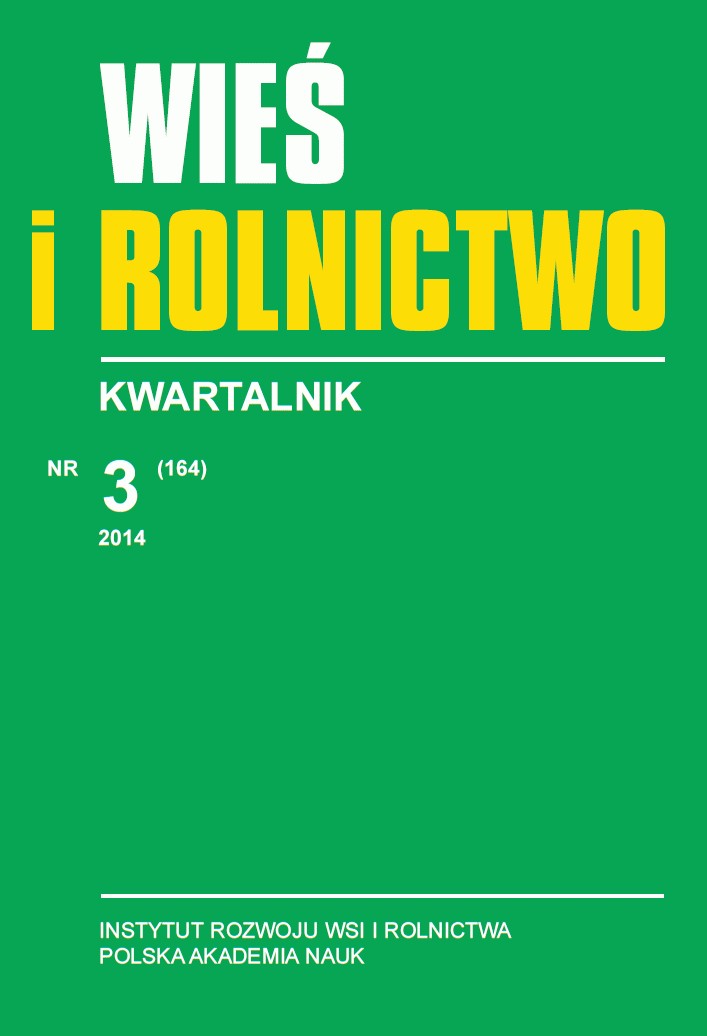A „sugar payment” and the income of sugar beet growers in Poland. Current status and prospects
DOI:
https://doi.org/10.53098/wir.2014.3.164/12Keywords:
sugar beet, sugar market in the World, the European Union, Poland, a separate sugar payment, profitability of sugar beet production, the reform of the sugar marketAbstract
The aim of this article is to present the importance of a separate sugar payment in Poland and its impact on the income of sugar beet growers in Poland. The article presents the structure and dynamics of the World, the EU and the Polish sugar market and sugar beet market, as well as the instruments of Common Agricultural Policy (CAP) for the sugar market, which provides a background for further consideration. The profitability of sugar beet production is shown in recent years in Poland and in comparison to Germany, one of the leaders in this sector of agriculture in the European Union. As results show in the paper sugar beet is being gradually displaced by sugar cane on a global scale. Following the reform of the sugar market (in 2006) in the European Union there many unfavourable changes occurred which have led to the cessation of sugar production in some countries, resulting in the total supply of this product decreasing and the EU becoming a net importer of sugar (even though for many years it had production surpluses and exported these). Sugar payments in nine countries, including Poland was one form of compensation for the loss of revenue of sugar beet growers caused by the introduction of this reform. According to the findings this payment is to be paid for the lasttime in 2014. Therefore it is necessary to consider the sense of the introduction of another support mechanism for sugar beet growers in Poland and other new member states of the European Union. An increase in the level of basic direct payment rate seems to be such a solution. It could improve profitability of sugar beet production in Poland.References
Agricultural Outlook 2013–2022, Organisation for Economic Co-operation and Development – Food and Agriculture Organization of the United Nations (OECD-FAO), OECD Publishing, http://dx.doi.org/10.1787/agr_outlook-2013-en. DOI: https://doi.org/10.1787/agr_outlook-2013-en
CAP towards 2020 Impact Assessment. Anex 5: Market Measures, 2013, European Commission, DG-AGRI, Brussels.
Chmielewski Ł., 2013a: Rynek cukru. Fundacja Programów Pomocy dla Rolnictwa (FAPA), Zespół Monitoringu Zagranicznych Rynków Rolnych (FAMMU), Warszawa, s. 3–8, 18–21.
Chmielewski Ł., 2013b: Światowy rynek cukru. Fundacja Programów Pomocy dla Rolnictwa (FAPA), Zespół Monitoringu Zagranicznych Rynków Rolnych (FAMMU), Warszawa, s. 9–12.
Chudoba Ł., 2004, Produkcja buraków cukrowych. Fundusz Współpracy, Warszawa, s. 12–15.
Czyżewski A., Stępień S., 2008, Wydatki budżetowe UE w sektorze rolnym – rekomendacje do dyskusji nad „health-check”. Zagadnienia Ekonomiki Rolnej, nr 2/2008, s. 3–18.
Czyżewski A., Stępień S., Borychowski M., 2014: Wpływ likwidacji tzw. płatności cukrowej na uprawę buraków cukrowych i produkcję cukru w Polsce. Ekspertyza na zlecenie Krajowego Związku Plantatorów Buraka Cukrowego.
Dane Głównego Urzędu Statystycznego.
Dane Krajowego Związku Plantatorów Buraka Cukrowego.
Dane Wielkopolskiego Ośrodka Doradztwa Rolniczego w Poznaniu.
Dane Wielkopolskiej Izby Rolniczej w Poznaniu.
Denger J., 2012: Richtwerte für Leistungen und Kosten der Zuckerrübenproduktion in zwei Ertragsstufen. Jena.
Etapy reformy rynku cukru. 2011, Ministerstwo Rolnictwa i Rozwoju Wsi, Biuro Prasowe, Warszawa.
Krzysiak Z., 2009: Opłacalność produkcji buraków cukrowych w warunkach reformy rynku cukru. Uniwersytet Przyrodniczy w Lublinie, Lublin, s. 119–126. DOI: https://doi.org/10.22630/EIOGZ.2011.87.9
Kwota zrealizowanych płatności w ramach uzupełniających płatności obszarowych – Płatności cukrowe w kampaniach 2006–2013. 2014, Agencja Restrukturyzacji i Modernizacji Rolnictwa, http://www.arimr.gov.pl/
Marcinkowska M., Narojczyk S., Stępień S., 2011: Kierunki zmian funkcjonowania wybranych rynków rolnych w kontekście ewolucji wspólnej polityki rolnej UE. [w:] Rozwój rolnictwa i obszarów wiejskich w warunkach ewolucji WPR: wybrane problemy, A. Czyżewski, S. Stępień (red.). Kujawsko-Pomorska Szkoła Wyższa w Bydgoszczy, Bydgoszcz, s. 81–97.
Overview of the implementation of direct payments under the CAP in Member States in 2012 (Reg. 73/2009). 2012, European Commission, Directorate – General for Agriculture and Rural Development, Brussels.
Polet Y., 2013: EU-27 Sugar Annual Report. GAIN Report No E80016, USDA Foreign Agricultural Service, Washington, s. 7–8.
Rozporządzenie Rady (WE) nr 318/2006 z 20 lutego 2006 r. w sprawie wspólnej organizacji rynków w sektorze cukru.
Rynki rolne – Cukier. 2014, Agencja Rynku Rolnego, http://www.arr.gov.pl/
Schneider I., 2013: So macht der Rübenanbau Spaß. Zuckerrüben Journal 3/2013.
Skarżyńska A., Augustyńska-Grzymek I., Ziętek I., 2005: Produkcja, koszty i dochody wybranych produktów rolniczych w latach 2003–2004. Instytut Ekonomiki Rolnictwa i Gospodarki Żywnościowej, Warszawa, s. 34–35.
Stawki płatności bezpośrednich. 2014, Agencja Restrukturyzacji i Modernizacji Rolnictwa, http://www.arimr.gov.pl/
Study on price transmission in the sugar sector (AGRI-2011-EVAL-03). 2011, Arete – Research & Consulting in Economics.
Sugar. 2014, European Commission, Agriculture and Rural Development, http://ec.europa.eu/agriculture/sugar/
Sugar: World Markets and Trade. 2013, United States Department of Agriculture, Foreign Agricultural Service/USDA, Office of Global Analysis.
Sugar and Sweeteners Yearbook Tables. 2014, United States Department of Agriculture, Economic Research Service, http://www.usda.gov/wps/portal/usda/usdahome.
Sugar Market Situation. 2014, European Commission, Agri C 4, Committee for the Common Organisation of Agricultural Markets, Brussels (30.01.2014).
Sugar Price Reporting. 2014, European Commission, Agri C 4, Committee for the Common Organisation of Agricultural Market, Brussels (30.01.2014).
Szajner P., 2011, 2012, 2013: Rynek cukru. Stan i perspektywy. IERiGŻ, ARR, MRiRW, nr 38, 39, 40.
Downloads
Article file downloads
Pages
How to Cite
Issue
Section
License
Copyright (c) 2014 Wieś i Rolnictwo

This work is licensed under a Creative Commons Attribution 4.0 International License.










